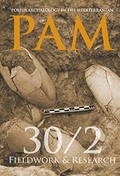The skeletal remains from Umm an-Nar tomb QA 1-1: spatial distribution and anthropological analysis
The skeletal remains from Umm an-Nar tomb QA 1-1: spatial distribution and anthropological analysis
Author(s): Łukasz Rutkowski, Marta ParolSubject(s): Archaeology, Cultural history, Local History / Microhistory, Ancient World, Cultural Anthropology / Ethnology
Published by: Wydawnictwa Uniwersytetu Warszawskiego
Keywords: Umm an-Nar; tomb; QA 1-1; Oman; collective grave; osteological examination; MNI; commingled bone deposits;
Summary/Abstract: Collective aboveground circular tombs of stone are one of the main categories of mortuary structures from the Umm an-Nar period (2500–2000 BC) in the Oman peninsula. The tombs have been known since the late 1950s but various aspects of their functioning still await a full explanation. Most of them survived in poor condition, often empty, only a dozen or so actually yielding any human remains. Tomb QA 1-1, one of ten Umm an-Nar-type tombs at Wadi al-Fajj in northwestern Oman, apart from anything else, is promising for bioarchaeological research, yielding a substantial assemblage of human skeletal remains (estimated MNI 25) from two of the four burial chambers excavated between 2016 and 2018. While the excavation of the tomb should be continued, a presentation of the bone assemblage recovered to date, including a distribution analysis of the remains, deposition characteristic, and preliminary osteological analysis, adds to the existing source base of Early Bronze Age populations in the ancient land of Magan.
Journal: Polish Archaeology in the Mediterranean
- Issue Year: 2/2021
- Issue No: XXX
- Page Range: 103-128
- Page Count: 26
- Language: English

